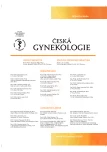Immunological principle of development of red blood cell alloimmunization in pregnancy, hemolytic disease of the fetus and prevention of RhD alloimmunization in RhD negative women
Authors:
L. Roubalová
; M. Lubušký
Authors‘ workplace:
Porodnicko‑gynekologická klinika, Lékařská fakulta Univerzity Palackého, Fakultní nemocnice, Olomouc, přednosta prof. MUDr. R. Pilka, Ph. D.
Published in:
Ceska Gynekol 2020; 85(6): 408-416
Category:
Review Article
Overview
Design: Review article.
Setting: Department of Obstetrics and Gynecology, Palacky University Olomouc, Faculty of Medicine and Dentistry, University Hospital Olomouc.
Methods, results: Every person exposed to a foreign red blood cell antigen (erythrocyte antigen) develops an antibody. If the contact with a foreign erythrocyte antigen occurs during pregnancy, the erythrocyte alloimmunization of the pregnant woman develops and, due to antibodies crossing through the placenta also Haemolytic disease of the foetus and newborn (HDFN) can occur. Antibodies are made by pregnant woman's immune system and their quantity and quality depend on many factors. Their function is to eliminate foetal "foreign" erythrocytes. Ways of elimination of antibody-labelled foetal erythrocytes are the same in the bloodstream of pregnant women and foetuses/newborns and their principle is type II hypersensitivity (cytotoxic), according to the Coombs and Gell classification. Severe forms of HDFN can lead to increased perinatal morbidity and mortality. Prevention of the development of RhD alloimmunization and severe forms of HDFN is based on the administration of polyclonal immunoglobulin (Ig) G anti-D in all potentially sensitizing events. It is assumed that the mechanism of anti-D IgG action is based on the rapid removal of the antigen by antibody overflow, and on antibody mediated immune suppression (AMIS). However, the exact immunological principle is not fully known yet.
Conclusion: This article describes the development of irregular antibodies, methods of foetal erythrocytes destruction and the mechanism of prevention of anti-D immunoglobulin from the immunological point of view.
Keywords:
erythrocyte (red blood cell) alloimmunization – hemolytic disease of the fetus and newborn – antigen "D" – antibody anti-D – type II hypersensitivity – antibody IgG – antibody IgM – RhD alloimmunization – polyclonal immunoglobulin IgG anti-D – AMIS
Sources
1. Belkina, EV., et al. Monoclonal immunoglobulin anti-D for prevention of hemolytic disease of the new-born. Transfus Clin Biol, 1996, 28 p.
2. Brinc, D., Lazarus, AH. Mechanisms of anti-D action in the prevention of hemolytic disease of the fetus and newborn. Hematology Am Soc Hematol Educ Program, 2009, p. 185–191. doi:10.1182/asheducation-2009.1.185.
3. Castillo, B., Dasgupta, A., Klein, K., et al. Transfusion medicine for pathologists 1st Ed. A Comprehensive Review for Board Preparation, Certification, and Clinical Practice, Elsevier, 2018.
4. Davis, RS., Ehrhardt, GR., Leu, CM., et al. An extended family of Fc receptor relatives. Eur J Immunol, 2005, 35, p. 674–680.
5. Hájek, Z., Čech, E., Maršál, K., a kol. Porodnictví, 3. zcela přepracované a doplněné vydání, Praha: Grada, 2014.
6. Hendrickson, JE., Delaney, M. Hemolytic disease of the fetus and newborn: modern practice and future investigations. Transfus Med Rev, 2016, 30(4), p. 159–164.
7. Higel, F., Seidl, A., Sorgel, F., Friess, W. N-glycosylation heterogeneity and the influence on structure, function and pharmacokinetics of monoclonal antibodies and fc Psion proteins. Eur J Pharm Biopharm, 2016, 100, p. 94–100.
8. Hořejší, V., Bartůňková, J. Základy imunologie 4. vydání. Praha: Triton 2009.
9. https://biology.estranky.cz/clanky/imunologie/komplement.html.
10. Kapur, R., Kustiawan, I., Vestrheim, A., et al. A prominent lack of IgG1-fc fucosylation of platelet alloantibodies in pregnancy. Blood, 2014, 123, p. 471–480.
11. Karlsson, MC., Wernersson, S., Diaz de Stahl, T., et al. Efficient IgG-mediated suppression of primary antibody responses in Fcgamma receptor-deficient mice. Proc Natl Acad Sci U S A, 1999, 96, p. 2244–2249.
12. Kittnar, O., et al. Lékařská fyziologie. 1. vydání. Praha: Grada, 2011.
13. Krejsek, J., Andýs, C., Krčmová, I. Imunologie člověka, Hradec Králové: Garamon, s.r.o., 2016.
14. Kumpel, BM. Efficacy of RhD monoclonal antibodies in clinical trials as replacement therapy for prophylactic anti-D immunoglobulin: more questions than answers. Vox Sang,.2007, 93, p. 99–111.
15. Kumpel, BM., Elson, CJ. Mechanism of anti-D-mediated immune suppression-a paradox awaiting resolution? Trends Immunol, 2001, 22(1), p. 26–31. doi:10.1016/s1471-4906(00)01801-9.
16. Lambin, P., Debbia, M., Puillandre, P., Brossard, Y. IgG1 and IgG3 anti-D in maternal serum and on the RBCs of infants suffering fromHDN: relationship with the severity of the disease. Transfusion, 2002, 42, p. 1537–1546.
17. Liu, J., Santhanakrishnan, M., Natarajan, P., et al. Antigen modulation as a potential mechanism of anti-KEL immunoprophylaxis in mice. Blood. 2016, 128(26), p. 3159–3168. doi:10.1182/blood-2016-06-724732.
18. Lubušký, M., Procházka, M., Šimetka, O., Holusková, I. Doporučení k provádění prevence RhD aloimunizace u RhD negativních žen. Doporučený postup ČGPS ČLS JEP. Čes. Gynek., 2013, 78(2), s. 132–133. (Guideline for prevention of RhD alloimmunization in RhD negative women).
19. Maier, CL., Mener, A., Patel, SR., et al. Antibody-mediated immune suppression by antigen modulation is antigen-specific. Blood Adv, 2018, 2(21), p. 2986–3000.
20. Payam Khaja Pasha, R., Shokri, F. Immunologic basis and immunoprophylaxis of RhD induced hemolytic disease of the newborn (HDN). Iran J Immunol, 2008, 5(4), p. 189–200.
21. Thomson, A., et al. Clearance of Rh D positive red cells with monoclonal anti-D. Lancet, 1990, 336, p. 1147–1150
22. Urbaniak, SJ. Alloimmunity to RhD in humans. Transfus Clin Biol, 2006, 13(1–2), p. 19–22.
23. Urbaniak, SJ., et al. Assessment of in vivo function of IgG1 and IgG3 monoclonal anti-D by clearance of Tc99 labelled autologous Rhesus D positive red blood cells. Transfusion, 1998, 38(Suppl.), 33 p.
24. Velkova, E. Correlation between the amount of anti-D antibodies and IgG subclasses with severity of haemolytic disease of foetus and newborn. Open Access Maced J Med Sci, 2015, 3(2), p. 293–297.
Labels
Paediatric gynaecology Gynaecology and obstetrics Reproduction medicineArticle was published in
Czech Gynaecology

2020 Issue 6
Most read in this issue
- Idiopathic polyhydramnios
- Total laparoscopic hysterectomy – clinical comparison of the method using two types of uterine manipulators
- Dienogest in the treatment of endometriosis
-
Importance of addition of HPV DNA testing to the cytology based cervical cancer screening and triage of findings with p16/Ki67 immunocytochemistry staining in 35 and 45 years old women
LIBUSE trial data analysis
